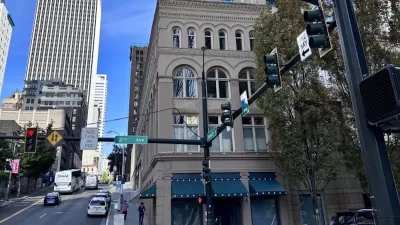A series of pieces from Sidewalk Labs examines the history and context of vital urban "innovations." So far, elevators, sewers, and traffic signals have been covered.

For Sidewalk Labs, Eric Jaffe introduces a series of articles on how urban life has generated some of the most world-changing technologies out there. The focus is on history and context. "One of the many problems with the term 'smart cities' is its suggestion that urban life has been dumb in the past."
Jaffe goes on, "Over the coming weeks, we'll explore some of the biggest steps forward — and, at times, backward — in transportation, buildings, energy, data, and infrastructure." Three pieces are out already, covering relatively recent inventions like elevators and traffic lights, as well as ancient ones like sewage systems (whose world-changing nature we cannot overstate).
There is wisdom to be gleaned from all of this. As Jaffe puts it, "The clearest lesson is that innovation never takes hold in cities overnight. That's been true even of the greatest leaps forward in urban technology. Steam accounted for a tiny fraction of U.S. power nearly 60 years after Watts invented his great engine." He also points to the role of policy and public-private collaboration in mainstreaming many of these inventions.
FULL STORY: 15 Innovations That Shaped the City

Montreal Mall to Become 6,000 Housing Units
Place Versailles will be transformed into a mixed-use complex over the next 25 years.

Planetizen Federal Action Tracker
A weekly monitor of how Trump’s orders and actions are impacting planners and planning in America.

DARTSpace Platform Streamlines Dallas TOD Application Process
The Dallas transit agency hopes a shorter permitting timeline will boost transit-oriented development around rail stations.

Study: 4% of Truckers Lack a Valid Commercial License
Over 56% of inspected trucks had other violations.

Chicago Judge Orders Thousands of Accessible Ped Signals
Only 3% of the city's crossing signals are currently accessible to blind pedestrians.

Philadelphia Swaps Car Lanes for Bikeways in Unanimous Vote
The project will transform one of the handful of streets responsible for 80% of the city’s major crashes.
Urban Design for Planners 1: Software Tools
This six-course series explores essential urban design concepts using open source software and equips planners with the tools they need to participate fully in the urban design process.
Planning for Universal Design
Learn the tools for implementing Universal Design in planning regulations.
City of Mt Shasta
City of Camden Redevelopment Agency
City of Astoria
Transportation Research & Education Center (TREC) at Portland State University
US High Speed Rail Association
City of Camden Redevelopment Agency
Municipality of Princeton (NJ)





























